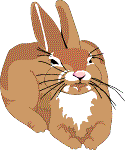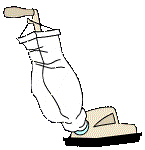Classroom Animals and Pets - Mammals - Rabbits
The 1989 World Book Encyclopedia definition for rabbits is:
1a. a burrowing animal about as big as a cat, with soft fur, a short, fluffy tail, long hind legs, and long ears. Rabbits can make long jumps and run very fast and they are sometimes raised for food or fur. They are rodent-like mammals that belong to the same order as the hare but produce young without fur, and include the gray European species and the American cottontails.
1b.= hare
2. the fur of a rabbit or hare.
3. = Welsh rabbit.
Sports
4a. a mechanical lure often shaped like a rabbit, used in dog races.
4b. a pacesetter in a race.
4c. a player in golf, chess, etc., who must participate in preliminary rounds to qualify for each event in a tournament.
4d. British. A poor tennis player or cricket batsman.
 Back to top
Back to top
A big thank you to Susan Zuckerman (teacher member #6) for writing the sections
on “Comments, Housing, Food, and Maintenance”. Susan’s specialty
is cooperative learning and her class members spend considerable time planning
for their classroom pet long before it is ever chosen. Her experiences with
rabbits in her classroom were evidently very rewarding!
NOTE:
Please note that according to some "rabbit experts"
there is some conflicting information in my feature article about rabbits as
pets.
I have not had one at school myself, and so this article expresses the experience
of another animal- loving teacher. I know that she takes a lot of care in both
her students and her class pets, however, her class pets only reside in the
classroom for a few months, so perhaps this has some bearing on the matter.
(The pet has a pre-designated home afterwards.)
I am including here the information passed on to me in
the Guestbook so that you can be better informed.
I know you will be checking more than one source
before choosing your class pet (!), so I highly suggest that you go to:
http://www.rabbitnetwork.org/
for some "rabbit specialist" information! Perhaps
you will choose to have a rabbit as a personal companion instead, and simply
bring it for a "visit" to your classroom.
Here is the information from my Guestbook Nov./05
I just happened upon your web site and was reading about rabbits in the
classroom. You have some excellent material in here about rabbits and it's wonderful
that you're teaching small children about care, committment and concern when
it comes to having a pet. You've definitely done your homework! Many of your
points on rabbits are excellent. However, I really think you need to take another
look at some of your other suggestions or at least revise your views based on
rabbits now and today.
Please take a look at this article for more information: http://www.rabbitnetwork.org/articles/classroom.shtml
Nb #1: For instance, "they are diurnal".
This is completely false. Rabbits sleep during the DAY and are most active at
dusk and dawn. They DO NOT like to be awake during the day. I have 4 that sleep
all day.
Nb #2: "A Dwarf or a Dutch-Dwarf Cross
will be fine in a cage that could fit on most desktops". Are you serious?!
Minimum cage requirements for ANY SMALL sized rabbit such as a dutch mix should
be 18"x24"x36". I don't think that size fits on a desktop.
Nb #3: "Young rabbits can be picked up
by the skin of their neck". That may be true for mother rabbits, but teaching
this to small children is NOT ideal at all. Rabbits should be scooped up, supporting
their butt and front legs and then held securely against the chest. "...you
shouldn’t let its feet dangle for long...If their feet dangle they kick
around and can scratch". They can break their poor backs, nevermind scratching
the kids! This is no way near proper instructions for small children on how
to hold a rabbit. You MUST revise this teaching as this is completely inaccurate
and inappropriate to teach young children.
Nb. #4: "Vitamins (added to water)"
- this is not true at all and completely unneccessary and any vet that is rabbit
savvy will tell you this.
Nb. #5: " Harness & Leash (for outdoors)"
- a rabbit should not be taken outdoors especially by young children. A rabbit
could very easily become spooked, take off, get caught in the harness, break
it's neck/back. Do you have the necessary monetary funds to pay for this vet
visit if this happens? If the rabbit does not injure itself in this scenario,
it could get loose if the child is not holding the leash properly. That could
lead to getting killed by a car, a predator, etc.
Nb. #6: "A water bottle is essential,
as rabbits will poop in a water dish" - I've had rabbits for 8+ years and
none of mine have every pooped in it's water dish. Could this be because the
cage is way too small? A rabbit should have a litterbox as well. This makes
the cage clean up MUCH easier as rabbits tend to "go" in one corner.
Nb. #7: "Rabbits are very cute and cuddly"
- rabbits are by NO MEANS cuddly. In general, rabbits despise being held and
cuddled. They prefer all 4 feet on the ground. They are ground dwelling animals
and many times being picked up is like being captured and picked up by a predator.
I really ask of you to please revise some of your opinions in this teaching.
Please take a look at this site for more up-to-date information: http://www.rabbitnetwork.org/
 Back
to top
Back
to top
Choosing a Rabbit for the Classroom
Of all the pets I have had in my classroom over the years, I think overall a
rabbit has been the best choice. Children and rabbits relate to each other beautifully,
rabbits are very interesting to observe and play with, and they are diurnal.*1
(Nb. Please see notes above). (A pet that sleeps all day is a little
boring.) The downside is that their cages need daily cleaning and they need
lots of exercise outside the cage; however, this helps the kids learn responsibility.
They also cost little to feed and maintain. You will probably want to choose
a small rabbit, a “ little bunny.” Larger rabbits need larger cages,
and as classrooms are generally limited in their space for pets, you’ll
probably want a fairly small cage. A Dwarf or a Dutch-Dwarf Cross will be fine
in a cage that could fit on most desktops. (We actually used a cage meant for
a Guinea Pig, and it was fine for a Dutch-Dwarf.) *2 (Nb.
see notes above) These smaller rabbits are also easier for children to
hold. Choosing a young bunny means that it will grow up being used to being
held and won’t be prone to bite. It will be also grow up being used to
the noise and bustle of the classroom, which I think is easier on its nerves.
Rabbits cost about $20-$40 (Canadian) at a pet store, depending on the breed,
making it a fairly inexpensive pet, one for which children could readily raise
money. Their food and straw costs little, also, less than $20 a month. (My students
raised money by bringing beverage cans and bottles from home, which I took to
the recycling depot once every few weeks, and this provided ample money.) A
rabbit is an ideal pet for Grades 3-5. They take a lot of work, so younger kids
might have a hard time doing it all, and older kids tend to get bored with all
the responsibility.
Holding a Rabbit
Young rabbits can be picked up by the skin of their neck, like a kitten, then
placed on your hand, held up against your chest, with the other hand then cupping
it around the tail area. *3 (Nb. see notes above)
As they grow bigger and heavier they don’t like being picked up that way,
and can be picked up with one hand under the front feet and one hand under the
back feet. If you’re chasing it and trying to catch it, grasping it gently
around the middle may be necessary, but you shouldn’t let its feet dangle
for long. Bunnies like to be held up against your chest, head up near your shoulder,
with their bottom supported. Caution: If their feet dangle they kick around
and can scratch. None of the
scratches my kids received ever drew blood or were complained about much, however.
You may need to “manage” the holding of a bunny in the classroom,
so there isn’t too much passing around and confusion for it. Discussing
with the kids who can hold it when is a good idea. We came up with something
like this: Recess and lunch it is Pet Care group only. In spare time throughout
the day it is one group per day. (We had one group bring News each day, so used
those same groups.) When the cage is being cleaned after school anyone who wishes
can hold it.
I (Susan) would highly recommend having a rabbit as a classroom pet. A close
bond forms between it and the children, more so than with a smaller animal.
 Back
to top
Back
to top
Basic Supplies
Cage with an easily cleaned bottom
Food Dish
Food Pellets
Water Bottle
Vitamins (added to water)
Harness & Leash (for outdoors)
Towel (or other cozy cloth for a bed)
Newspaper (for lining bottom of cage)
Straw (a little for on top of the newspaper)
Book on Rabbit Care
We found a Guinea Pig cage to be fine for our little Dutch-Dwarf, and it fit
nicely on a desk-top. A larger cage might be better for the sake of exercise,
but is also harder to clean and carry. Our cage had a detachable bottom which
made cleaning easy. We lined the bottom of the cage with newspaper, and added
a little straw as well. Because rabbits poop so much and their cage needs cleaning
every day, we found that using wood shavings was too expensive. A water bottle
is essential, as rabbits will poop in a water dish. #5
(Nb. See notes above.) A sturdy petfood dish keeps them from tipping
their food. We added a cozy little hand-towel for it to sleep on. At first we
had a hide-box (just a little cardboard box with a door cut out), and especially
when the rabbit was new to the classroom she liked to go in there to feel safe.
As she grew, however, space inside the cage seemed to be more important, and
we removed the box.
 Back
to top
Back
to top
Pellets purchased from a pet food store are the preferred staple food. Every
other day we gave our rabbit alfalfa. A variety of fresh fruits and vegetables
is important. The kids brought these from home: carrots, celery, apples, bananas,
and pears. Weeds picked from outside were mainly dandelions and clover, and
also grasses. Consult a book on the care of rabbits for other appropriate foods,
which may be more available where you live. Something to avoid is lettuce, which
gives them diarrhea. We fed the rabbit pellets only once a day, when the cage
was cleaned, but might give her fresh fruits and veggies throughout the day.
The water in the water bottle should be changed daily, with a few drops of vitamins
added. #4 (Nb See notes above). It may seem like
a waste to throw out the vitaminized water, but a small bottle of vitamins lasts
for many months and is not expensive.
 Back to top
Back to top
Organizing Care of a Rabbit in the Classroom
Rabbits are very cute and cuddly, but are a lot of work. #6
(Nb. See notes above.) They poop a great deal, and their cage needs cleaning
daily. They also need lots of exercise, so plenty of time out of their cage
must be built into each day.
Here’s how we organized all this:
One group of 3-4 students had the Pet Care job each week. Every day they had to clean the cage and provide a little fresh food from home. They also were responsible for giving the bunny exercise for the whole of recess and lunch hour, and had special permission to stay in to do this. Our classroom had a courtyard outside, so on nice days they ate lunch out there, and let the bunny roam free. On cold or rainy days they kept the bunny in the classroom, and let it roam free in there. Rabbits cannot stay alone in the classroom over the weekend. This would be too cruel! Our rabbit went home each weekend with a different student, with parent permission. (This is another reason to have a small bunny, so the cage can be small and easily carried home.) A bag of food, the harness and leash, a book about care of rabbits, etc. would go home as well. Our rabbit slept on a cozy towel, so this student would also be responsible for laundering this towel.
Clipping Claws
If your rabbit is able to dig in the dirt, or run about on concrete or asphalt, the claws may not need clipping often. Occasional clipping may still be needed, however. Clippers for dogs are fine, and can probably be borrowed for as often as you’ll need them. Clipping a rabbit’s claws is a 2-person job, one to hold the rabbit and the other to clip. Having a person experienced with
clipping a dog’s claws would be an asset. When you clip, notice that in each claw is a pinkish portion. This area contains blood vessels, and it will hurt the rabbit to cut into this.
Exercise and Roaming Free
If for some reason our rabbit did not get exercise, for example if we were away all day on a field trip, she would shake the cage a go a little nuts. This made us realize how very important it was for her to roam around free. Besides the recess and lunch exercise, whenever we had quiet, still times in the classroom, for example during read-aloud story time or silent reading, we would also let her roam around the classroom. Inside the classroom she loved to explore. The main danger was chewing on electrical cords. We had to make sure these were always out of her reach. She
usually did her toileting in one corner, so we kept newspaper there and she
generally went on that or close by. Rabbit turds all around the classroom were
not a problem. The Pet Care group was also responsible for cleaning up any little
messes she made. (Rabbits turds are dry and easily picked up with a dustpan
and paper towel.) Outside the classroom, roaming free is also important. An
enclosed area is ideal, for instance a courtyard. Rabbits need to dig in the
dirt to keep their claws from growing too long or being too sharp (for those
inevitable little scratches the kids will get.) Concrete or asphalt will also
help wear down their claws. Once a week, generally last period on Fridays, we
had a group of kids take the bunny out on the grass field. She wore a little
harness, and the kids held her on a leash so she wouldn’t get lost, but
followed her rather than led her. #5 (Nb. See notes above).
Rabbits love to eat grass, clover, and dandelions, so this outing was a special
treat for her. We did not have her out on the playground during recess and lunch
because it would be too hard to manage all the kids wanting to hold her, and
probably too hard on her nerves.
 Back to top
Back to top
Rabbits live in most areas of the world, excluding Antarctica. Rabbits generally live in fields, prairies, or marshes, where the young can be hidden in tall grasses or shrubs. Some varieties, however, can also be found in deserts, mountains, forests, and in the tundra. The shallow hole that most rabbits live in is called a form. It is a bowl shaped depression hidden in grasses, shrubs or leaves. The winter den is most substantial in northern climates. Rabbits do not dig their own burrows, but move into ones abandoned by other animals such as prairie dogs, badgers or skunks. Most rabbits live alone, but several may make their dens in the same area.
There are two main types of wild rabbits, cottontails and European rabbits. The cottontails live in North America. Domestic rabbits are tamed European rabbits. Some mention of raising them as pets is from as early as the Sixth Century. Queen Elizabeth of England, in the Sixteenth Century, started the fad of rabbits as pets with the aristocracy. There are as many as fifty different types of domestic breeds today, ranging in size from guinea pigs to small spaniels. In the wild they often only live a year or so, but pet rabbits may live 5 or more years.
Rabbits were once classified as rodents because of their chisel-like front teeth, which are made for gnawing. Unlike rodents, however, rabbits have a small pair of teeth behind the upper front teeth. Rabbits and Hares both belong to the order Lagomorpha, which means hare-shaped. Most rabbits are smaller and have shorter ears than hares. The easiest distinction, however, is that newborn rabbits are altricial (born blind, naked, and helpless) whereas newborn hares are precocial (eyes open, fully haired, and can run within minutes of birth). All domestic lagomorphs are true rabbits.
 Back to top
Back to top
• Rabbits are best known for their method of locomotion. They hop, rather than walk, using their long hind legs to push and their short front legs to balance. They can reach speeds of 29 kilometers (18 miles) per hour when being chased.
• They are also known for their short fluffy tails and soft fur.
• Rabbits are generally colored black, brown, gray, white, or combinations of these.
• Their eyes are on the sides of their heads so they can see behind or to the side better than they can see in front of them.
• Rabbits have long ears that can move independently to catch faint sounds.
• They have a keen sense of smell to alert them to danger. Their noses seem to twitch constantly.
• Rabbits can have two to nine young, but generally have four or five young, called kits or kittens. The female is pregnant for about a month. She keeps the young in a nest she has dug and lined with grass and fur she has pulled from her chest. She does not stay in the nest, but covers them with the grass and fur and remains nearby. The mother feeds them for only a few weeks after birth. The babies have fur and open eyes by about 10 days old and first leave the nest at about two weeks old. They often build their first forms close to the original nest.
 Back to top
Back to top
• Study the anatomy of the rabbit. Notice such characteristics as the side-placed eyes, chisel front teeth, long ears, short front legs and long back legs.
• Watch a rabbit hopping. Study how the legs move and where they are placed. Let the rabbit run over a smooth area of sand and then study the tracks.
• Observe your rabbit on its outside activities. Where does it like to go? Does it like open or protected areas. Does it move in straight lines or random movements? Does it show any extra alertness for danger (ear movements, sitting up etc.)?
• Watch a rabbit eating. Study how the teeth and lips are used. Does it use its paws?
• Study the rabbit’s hearing by making different kinds of sounds at different locations. Watch how the ears move together and independently. (Note: keep loud noises to a safe level).
• Experiment with different foods. Which are the rabbit’s favourites? Keep the rabbit’s favourite treat aside for one day and then experiment the next day to see whether the rabbit can smell the treat when it is hidden nearby.\
• If you purchase a young rabbit, weigh it weekly and chart its growth. Chart the growth of the length, the ear size, and hind leg lengths. Keep track of the amount of food eaten and compare this to the increases in growth.
• Ontario Ministry of Education Writing Activity: The difference between rabbits and hares. Read about this idea at the following website. http://www.ncboard.edu.on.ca/learning/d2-g5-le.htm
 Back to top
Back to top
ASPCA Pet Guide Care for Kids.
I haven’t read the one for rabbits but the one for hamsters is excellent so I’ll bet this one is too!
Kramer, David C. Animals in the Classroom. U.S.A.: Addison-Wesley, 1989.
Schneider, Earl (editor). Enjoy Your Rabbit. New York: The Pet Library
Ltd., (date?).
Check out the Rabbit Network for good information.
http://www.rabbitnetwork.org/
For a list of good books on rabbit care, the House Rabbit Society has developed this web page:
http://www.rabbit.org/links/sections/books.html
A web page on pet books
http://www.petloves.com/noframes/books/rabbits.htm
A web page with rabbit magazines.
http://www.yahoo.ie/Science/Biology/Zoology/Animals__Insects__and_Pets/Mammals/Rabbits/Magazines/
 Back to top
Back to top
The House Rabbit Society has an excellent website devoted to the love and care
of rabbits. There is also a “kid’s page” which has some interesting
reading and fun information.
http://www.mahouserabbit.org/infopack.shtml
http://www.rabbit.org/index.html
The House Rabbit Society does not recommend a rabbit as a classroom pet unless you seriously consider the items contained in this important article.
http://www.rabbit.org/faq/sections/classroom.html
Here is another House Rabbit Society article, focusing on “children and rabbits”.
http://www.rabbit.org/faq/sections/children.html#overview
The PetBunny Homepage has bunnies listed from all over the world. Each of these bunnies appears to have his/her own website that you can link to!
http://www.alumni.caltech.edu/~meanie/petbunny.html
Information on how to house train a bunny.
http://www.delphi.com/pets/trainbun.html
Julie’s links to rabbit websites
http://www.geocities.com/SiliconValley/Park/7689/links-rabbits.html
BC SPCA pet care guide to rabbits
http://www.bcyellowpages.com/advert/b/BCHES/rabbit.htm
Rabbit care information
http://www.ultranet.com/~hrs/infopack.htm
Massachusetts House Rabbit Society
http://www.mahouserabbit.org/infopack.shtml
 Back to top
Back to top
 Back to Mammals TOC
Back to Mammals TOC
This page revised December 1998.

 Back to the T.O.C. (Getting around...)
Back to the T.O.C. (Getting around...) Acknowledgement to Contributing Author
Acknowledgement to Contributing Author Comments (by S. Zuckerman)
Comments (by S. Zuckerman)
 Maintenance (by S. Zuckerman)
Maintenance (by S. Zuckerman)
 Characteristics
Characteristics